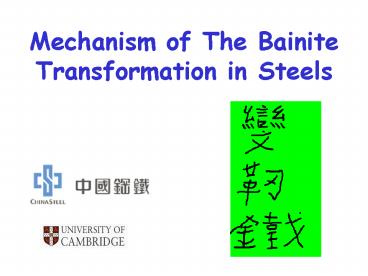Mechanism of The Bainite Transformation in Steels - PowerPoint PPT Presentation
Title:
Mechanism of The Bainite Transformation in Steels
Description:
Mechanism of The Bainite Transformation in Steels. Harry Bhadeshia. Bundy (1965) ... The nucleation of bainite must involve the partitioning of carbon ... – PowerPoint PPT presentation
Number of Views:1016
Avg rating:3.0/5.0
Title: Mechanism of The Bainite Transformation in Steels
1
Mechanism of The Bainite Transformation in Steels
Harry Bhadeshia
2
Bundy (1965)
3
body-centred cubic
cubic close-packed
4
DISPLACIVE
RECONSTRUCTIVE
5
(No Transcript)
6
upper bainite
1 µm
7
lower bainite
8
Surface 1
Surface 2
50 µm
Srinivasan Wayman, 1968
9
s
d
c
r
1
10
(No Transcript)
11
(No Transcript)
12
50 µm
13
(No Transcript)
14
Carbon supersaturated plate
Carbon diffusion into
Carbon diffusion into
austenite and carbide
austenite
precipitation in ferrite
Carbide precipitation
from austenite
LOWER BAINITE
UPPER BAINITE
(Low Temperature)
(High Temperature)
15
Fe-0.4C wt
Decarburisation time / s
Temperature / C
16
(No Transcript)
17
Temperature
Ae3'
T'
o
x
Carbon in austenite
18
(No Transcript)
19
(No Transcript)
20
Growth is diffusionless.
Strain energy must be accounted for.
21
(No Transcript)
22
Carbon supersaturated plate
Carbon diffusion into
Carbon diffusion into
austenite and carbide
austenite
precipitation in ferrite
Carbide precipitation
from austenite
LOWER BAINITE
UPPER BAINITE
(Low Temperature)
(High Temperature)
23
(No Transcript)
24
Oka and Okamoto
25
Ohmori and Honeycombe
26
Thermodynamics
g
a
Gibbs free energy
x
Carbon
27
(No Transcript)
28
(No Transcript)
29
Each point represents a different steel
Bhadeshia, 1981
30
The nucleation of bainite must involve the
partitioning of carbon
Why does the required free energy vary linearly
with T?
31
hexagonal close-packed
cubic close-packed
Christian, 1951
32
Brooks, Loretto and Smallman, 1979
33
Olson Cohen, 1976
34
(No Transcript)
35
(No Transcript)
36
(No Transcript)
37
Nucleation of bainite must involve the
partitioning of carbon.
Mechanism of nucleation is otherwise identical to
that of martensite.
38
(No Transcript)
39
Fe-2Si-3Mn-C wt
800
B
S
600
Temperature / K
400
M
S
200
0
0
0.2
0.4
0.6
0.8
1
1.2
1.4
Carbon / wt
40
Fe-2Si-3Mn-C wt
1.E08
1 year
1 month
Time / s
1.E04
1.E00
0
0.5
1
1.5
Carbon / wt
41
g
g
a
a
a
20 nm
42
Summary
The mechanism of transformation is
displacive. Transformation temperature higher
than martensite. Bainite grows without
diffusion. But carbon then escapes into the
residual austenite. Shape deformation plastically
accommodated. Sub-unit mechanism of
growth. Nucleation must involve carbon
partitioning.
43
(No Transcript)
44
(No Transcript)
45
(No Transcript)
46
(No Transcript)
47
(No Transcript)
48
Watson and McDougall, 1973
49
(No Transcript)
50
(No Transcript)
51
(No Transcript)
52
Summary
Mechanism displacive but carbon must partition
during growth. Pairs of plates grow together to
minimise strain.































